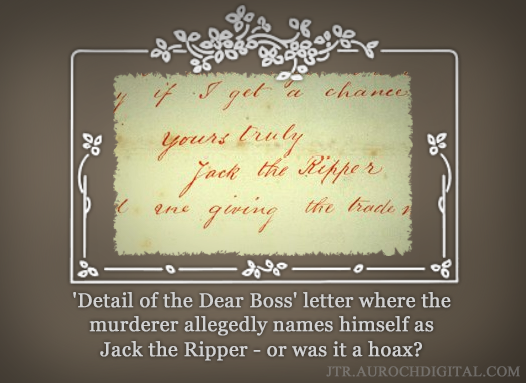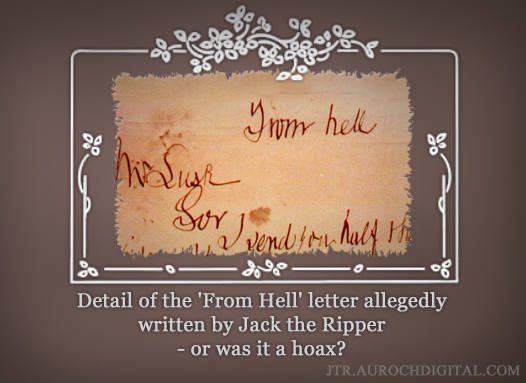The infamous Jack the Ripper murders are arguably the most famous unsolved crime in history. Over 125 years later they still cast a long shadow, one that stretches from 1888's Whitechapel to the current day.

What is my interest in these crimes? I'm a game designer and professed 'ripperologist' working on a new project about the Jack the Ripper murders. My interest was sparked when I read Alan Moore and Eddie Campbell's seminal graphic novel 'From Hell' many years ago. That fascination has culminated in work on a playable documentary on this topic (you can follow our progress by signing up to our project here). I've stumbled across a great many interesting things while doing deep research on the topic and I wanted to share some of them with you.
Over the decades hundreds of theories have been put forward as to the identity of the killer; but while it's certainly the biggest mystery of the case, who he was is by no means the whole story. One of the things that make the search for the culprit both interesting and confusing is that you soon encounter layer upon layer of further mystery surrounding the case. Below are five lesser known mysteries that are hidden within the puzzle of who Jack the Ripper was...
___________________________________
1. The name 'Jack the Ripper'
It's a well known name to us now, a part of our popular culture -- but where did the name come from and is that really the title the killer gave himself?
When the murders began in the autumn of 1888, the newly emergent newspaper industry was starting to realise that death was good for business: 'if it bleeds, it leads'. To cement them as a tabloid sensation, the murder cases needed a catchy name to hang the sensationalism on. In the early days of the case the murderer was given the name 'Leather Apron', the nickname of a local man who became one of the first high profile suspects. As John 'Leather Apron' Pizer ceased to be an ongoing suspect, a dramatic communique, known as the 'Dear Boss Letter' (one of many, many letters connected to the case) was received by the Central News Agency. The letter claimed to be from the killer and was signed 'Jack the Ripper'.

The name was the perfect tabloid identity for this unknown boogeyman. It worked so well because it drew on the real world crimes of the 'High Rip' gangs and also the popular folklore villain 'Spring Heeled Jack' who was known for attacking women. Its powerful connotations within the public psyche meant it struck a chord and stuck so firmly that it still resonates today. 'Ripper' is now used as a cultural shorthand for a vicious murderer and has been appended onto many other cases: the Yorkshire Ripper, the French Ripper, the Dusseldorf Ripper... the list goes on. It has even infected our technological spaces: Google 'Jack...' and you only get a few letters in before 'The Ripper' is suggested. In fact, It's almost too perfect; I'm of the opinion (as are plenty of other ripperologists) that an 'enterprising' journalist at the Central News Agency faked the letters and coined the name. Knowing either way would be a huge help to the case, but nobody seems to be 100% certain.
___________________________________
2. The number of victims
How many women did Jack kill? Depending on who you ask it could be anywhere between four and upwards of fifteen!
Serial killers often have a 'signature' to their murders; a methodology and ritual that forms a part of their warped fantasy of the event. That signature also helps law enforcement track which crimes might be theirs. Most books on the subject attribute five killings, known as the 'Canonical Five', to Jack. These are: Mary Ann Nichols, Annie Chapman, Elizabeth Stride, Catherine Eddowes and Mary Jane Kelly. I feel the names matter as we deal with the case as they were real people with hopes and dreams. The Ripper murders happened well before many of the key physical and psychological forensic tools we have today, however there does seem to have been a clear modus operandi: he engaged with them so as to get close, cut their throat and then mutilated the body. So while three of the canonical murders are clearly part of this pattern, two of them are a little different: Elizabeth Stride and Mary Kelly. Elizabeth Stride exhibited the same pattern of having her throat cut but not the bodily mutilation -- was this because the killer was disturbed or that it was not the same hand that ended her life? Mary Kelly's murder was by far the most vicious and exhibited almost total mutilation. Was this because it was the only one that didn't happen on the street and so the killer had more time?

Then there are other murders that various ripperologists attribute to Jack. Notable amongst these are Martha Tabram who was found murdered 24 days before the first of the Canonical Five -- was this Jack's first kill, hence the reason it was different from the others? What about the later murders of Rose Mylett or Alice McKenzie? Or the unidentified female torsos found dumped in and around the Thames both before and after the Canonical Five were found? Or indeed one or more brutal murders of women that happened later in the USA? Without even knowing who he killed, it's hard to know what evidence to rule in or out.
___________________________________
3. The Lusk Kidney
In mid October 1888 a known personality of the time, George Lusk, was sent a letter with an accompanying portion of human kidney that, it was claimed, had been removed from the body of Catherine Eddowes. Was this body part indeed from one of the victims and was it really the killer who sent it to Lusk?

It is key to note that Lusk was chair of a high profile 'Whitechapel Vigilance Committee' whose self-appointed task was to mount vigilante patrols of the area in an attempt to prevent more murders. This letter is known as the 'From Hell' letter, named after the 'posting address' on the top-right. This portion of kidney was examined by Dr Thomas Horrocks Openshaw who concluded that it was human but was unable to tell much more with any certainty; neither the gender or the age of the kidney, or how long it had been out of it's poor owner's body. It had been preserved in alcohol so any further evidence he might have been able to get from it was sadly lost. If this kidney was from Catherine Eddowes then it almost certainly means the letter in question was genuine, meaning that we have solid evidence in the form of his handwriting. It also means that most of the other letters can be discounted. Of course, it also could have been a piece of kidney stolen from a medical sample bottle by some trickster having a lark at the expense of the police (for the lulz). If we knew either way it would eliminate another line of enquiry, but it remains a mystery.
___________________________________
4. 'The Juwes' Graffiti
Close to one of the murder sites was written a puzzling piece of graffiti -- was this the murder leaving a cryptic clue or some random scrawls whose connection is purely circumstantial?
The graffiti read (or so we think) 'The Juwes are the men that will not be blamed for nothing'. It's a strange bit of writing with many puzzling aspects. Firstly who are the Juwes? Does this refer to 'Jews' as in the Jewish people? Certainly there were a lot of Jewish refugees living in that area. Indeed a number of the suspects were Jews and there had been attempted 'reprisal' attacks as some Londoners turned on the easy targets, blaming immigrants for the crimes. It may be nothing of the kind, not a misspelling of Jews at all but something else entirely. Indeed some have claimed the word 'Juwes' has a Masonic connection. Secondly is the strange double negative in the sentence, '...will not be blamed for nothing'. What does this mean? That the subjects of the graffiti are rightly or wrongly blamed for it? Thirdly, what is it they are being blamed (or not) for? The murders? As if this were not a mystery enough, on the night it was found Police Commissioner Charles Warren (a Freemason) said he was fearful of reprisal attacks against Jews and ordered it to be washed off even before the police photographer could document it. This is why the wording is uncertain as we only have police notebooks as a record of it. Is the graffiti a killer clue or a conspiracy theory red herring?
___________________________________
5. Why did he stop?
Serial killers don't just stop, do they? Why did these murders come to an end? Or did they? This is a key mystery for within it are clues as to the murderer's identity.
If Jack the Ripper was Aaron Kosminski as recent claims of a retrospective DNA test claim, then they stopped because he was incarcerated in an asylum. If he was Montague John Druitt then they stopped because he had committed suicide. If you think Jack was the painter Walter Sickert (as crime writer Patricia Cornwell did) then as he lived another 54 years after the killings, so why did the stop there? So you might be of the view that they didn't stop and he went on to continue to kill, varying his methods to throw law enforcement off the scent. Figuring out why Jack might have stopped would give clear insight into who he was -- the problem is that ripperologists can't agree he did...
___________________________________
I hope this brief dip into some of the puzzling aspects of the case gives you some insight as to why it is such a complex case. This is one of the reasons why I think that our approach to the mystery -- via gaming as a tool -- might offer to shed some light on the situation. We are looking to do this via our GameTheNews project, which looks to turn news and commentary into playable experiences. We've been exploring how we can use game-engines to build a simulation of Whitechapel in 1888 and then allow the player to move around, exploring the 'psychogeography' of the space and giving us data on how the physical spaces connects to the crimes. If you want to know more on this, please do sign up to our GameTheNews newsletter, Facebook and Twitter.
